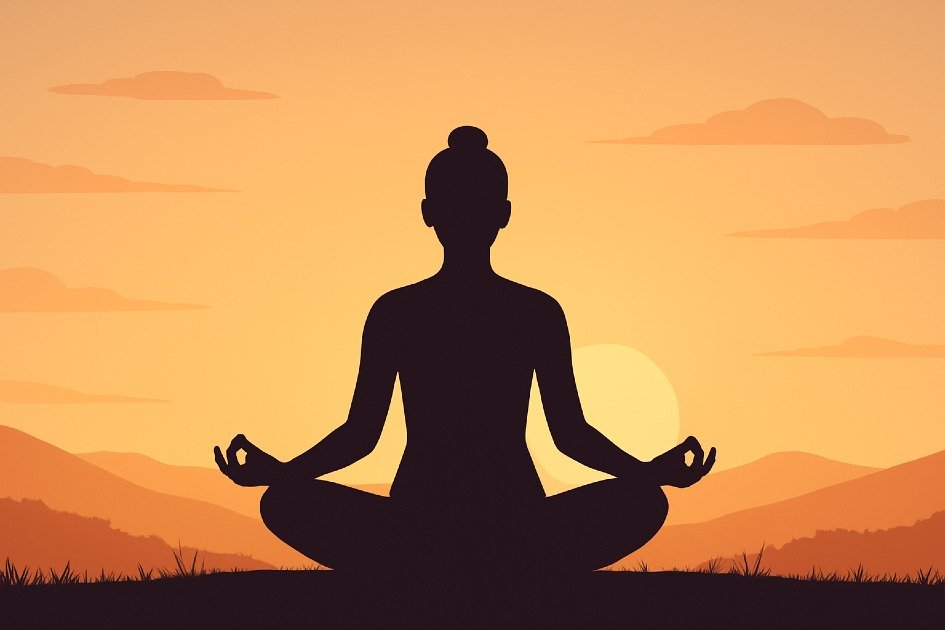Mindfulness Practices are a powerful tool that transforms ordinary moments into opportunities for clarity, peace, and presence.
Harvard Health emphasizes mindfulness as a method that helps individuals observe their thoughts, emotions, and sensations without judgment, thereby fostering a deeper connection to the present moment.
They help us stay grounded in the present moment, reducing stress, sharpening focus, and strengthening emotional balance. Consistent mindfulness can lower blood pressure, improve sleep, and enhance memory.
These practices do not require extensive meditation or complex rituals and can be as simple as taking slow breaths or noticing the rhythm of your footsteps.
Mindfulness practices build lasting inner resilience and can be carried anywhere, creating a calm center that cannot be disturbed by noise. Start with a quiet corner, notebook, or guided session.
Mindfulness practices can help reclaim focus, nurture inner peace, and live more fully in every moment, fostering inner peace and reshaping the way we experience the world.
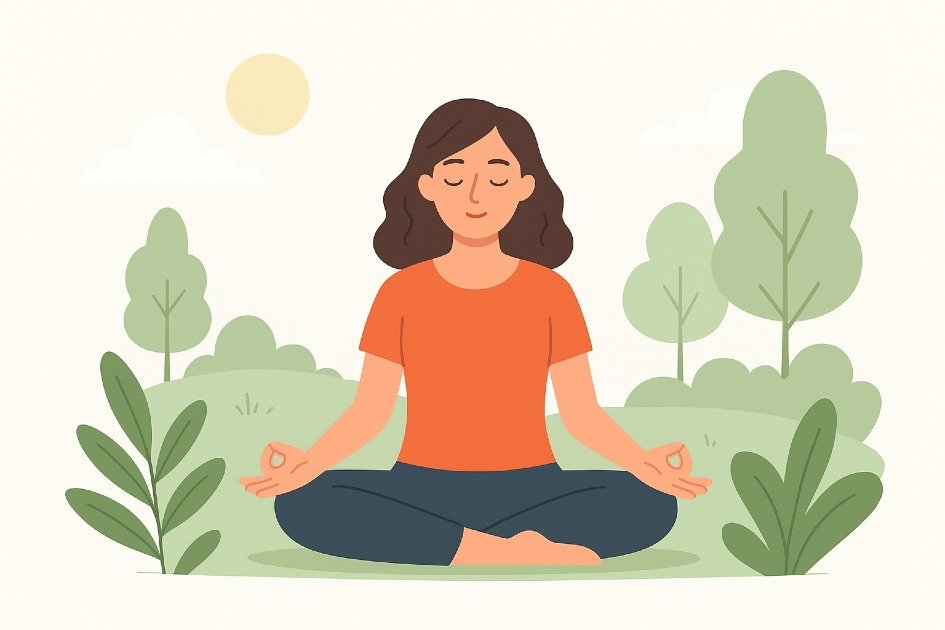
What is Mindfulness
Mindfulness involves focusing on the present moment, slowing down, and noticing surroundings, reducing stress, and improving focus through small practices like mindful breathing or meal savoring.
The Simple Definition of Mindfulness
Mindfulness involves focusing on the present moment without judgment, yet many people live distracted, causing drainedness and disconnectedness due to constant mental noise.
Engage in mindfulness practices, such as noticing breath, observing surroundings, or deeply listening, to anchor yourself to the “now” and transform rushed routines into calm rituals.
Each morning, I start with two minutes of mindful breathing. It clears my mind and helps me stay calm all day.
How Mindfulness Impacts Your Mind, Body, and Emotions
Overwhelming life leads to constant thought, causing stress, tension, and body reactions like headaches, shallow breathing, poor digestion, and emotional fluctuations from irritation to fatigue.
Harvard Health suggests that guided breathing, observing inhalation and exhalation without judgment, can calm the mind, reduce stress, and promote a more mindful life.
Mindfulness practices calm the nervous system, improve focus, sleep, energy, and emotional balance, offering a practical antidote to stress and anxiety.
Mindfulness practice helps me to slow down and focus on my breath. Breathing in and out helps me release stress and calm my mind. Sometimes, I use mindfulness platform to guide me and keep me on track.
The Science-Backed Benefits of Daily Mindfulness
Stress, anxiety, and burnout are physiological issues that weaken the immune system, cause memory issues, and negatively impact mood, leading to a health depletion cycle.
Daily mindfulness practices significantly improve health by reducing cortisol levels, lowering blood pressure, and strengthening brain regions related to focus and empathy, even for just ten minutes a day.
Start with mindful pauses before meetings, meals, or bedtime, like a drop of water, and over time, accumulate into a reservoir of peace.
When I practice mindfulness every day, I sleep better and wake up refreshed. It clears my mind, calms my body, and keeps my emotions steady. Simple daily mindfulness habits make a real difference in my rest and focus.
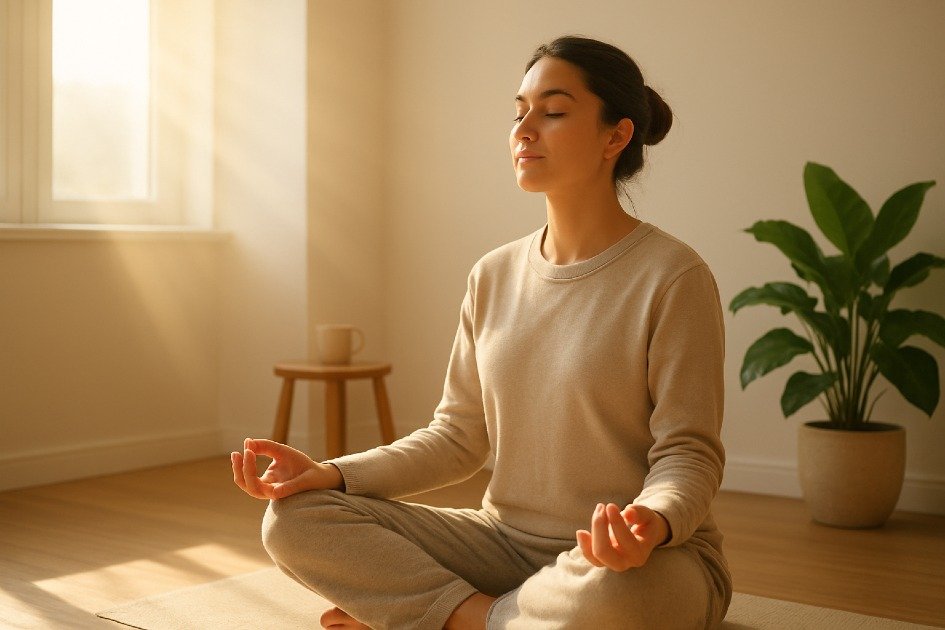
Morning Mindfulness Rituals to Set the Tone
Incorporating mindfulness practices in the morning can significantly improve energy, clarity, and emotional balance. Practical rituals are provided to set a calm and focused tone for the day.
Breathing Exercises to Start the Day with Calm Energy
Why it matters:
Breathing is crucial for mental and physical health; shallow, shallow breathing increases stress, while conscious, slow breathing signals calmness. Morning breath work clears mental fog, reduces anxiety, and prepares the nervous system for focus.
How to do it:
- Sit tall on a chair or bed, keeping your back straight.
- Breathe in through your nose for four counts, hold for two, then breathe out slowly through your mouth for six.
- Breathe for 5–10 minutes, feeling your body relax with every exhale.
- Use a mindfulness app with guided sessions to track your progress.
Mindful Stretching to Wake Up Your Body and Mind
Why it matters:
Morning stiffness can be alleviated by mindful stretching, which boosts blood flow, awakens senses, and trains the brain to remain present, reducing tension and improving posture.
How to do it:
- Stand straight with your feet shoulder-width apart.
- Lift your arms overhead as you breathe in, feeling your spine stretch.
- Breathe out and bend forward, letting gravity pull you down gently.
- Do simple stretches: roll your neck, lift your shoulders, and twist your torso gently.
- Focus on how each stretch feels, not on doing it perfectly. Every move is a chance to practice mindfulness.
Gratitude Journaling for a Positive Mindset
Why it matters:
Journaling enhances focus and optimism by making intentions tangible, while rewiring the brain to appreciate positive experiences, reducing stress and negativity.
How to do it:
- Use a small notebook or a journaling app to quickly capture ideas and track your progress.
- Every morning, list 3–5 things for which you are thankful.
- Set clear daily intentions, like ‘I will listen closely’ or ‘I will pause before reacting.’
- Notice how gratitude makes your body feel— warm, calm, or full of energy.
Mindful Hydration to Awaken Your Senses
Why it matters:
Overnight dehydration can cause fatigue, irritability, and poor focus. Mindful water intake signals the body to wake up, primes digestion, and boosts energy levels.
How to do it:
- Place a glass of water by your bed.
- Pause before drinking. Feel the coolness, see the clarity, and smell the freshness of your water.
- Drink slowly, letting the water refresh your throat, fill your stomach, and energize your body.
- Take a deep breath as you do this to make it part of your morning mindfulness routine.
Morning Visualization to Align Goals and Mood
Why it matters:
Visualization enhances productivity and emotional resilience by triggering the brain to perceive success and calmness, thereby boosting motivation and reducing stress responses throughout the day.
How to do it:
- Close your eyes and sit still for 3–5 minutes, focusing on your breath.
- Picture your day going well, finishing each task with focus and ease.
- Use your senses: notice the sights, sounds, and the proud feeling when you achieve something.
- Finish with a deep breath and tell yourself, ‘I am calm, focused, and ready for today.’
I use mindfulness to turn stress into focus, tension into energy, and everyday routines into meaningful rituals. Small, consistent steps help me stay clear, strong, and intentional every day.

Mindfulness at Work: Staying Present on a Busy Day
Mindfulness practices can help maintain productivity and mental clarity in a chaotic workday. By implementing small, deliberate habits, you can transform your workday from chaotic to controlled, ensuring you stay present and effective.
Focusing During Long Meetings or Tasks
Why it matters:
Multitasking during meetings reduces comprehension and retention, while maintaining presentness enhances engagement, builds credibility, and allows meaningful contributions.
How to do it:
- Pause and take three slow breaths to calm your mind before the meeting begins.
- Use a notepad to capture key ideas—writing keeps your mind sharp and focused.
- Check your posture often. Sitting tall helps your brain stay alert.
- When your mind wanders, bring it back to the talk calmly and without blame.
When I practice mindfulness at work, I notice that I absorb information faster and stay calm. Even long meetings feel less tiring and more productive.
Using Mindful Breaks to Recharge Your Productivity
Why it matters:
Working long hours can lead to cognitive fatigue, decreased efficiency, and creativity. Mindful breaks can restore focus, reduce stress, prevent burnout, and improve decision-making.
How to do it:
- Take a 2–5-minute break from your desk every hour. Stand up, stretch, or walk around to refresh your body and mind.
- Pay attention to your breathing or notice what is around you with a calm mind, without judging it.
- Take a quick walk or stretch, focusing on how your body moves with each step or bend.
- Use a guided meditation app for a fast mental reset.
When I take a short mindful pause, my energy return and my focus sharpens. These tiny breaks act like quick resets that keep my mind clear and strong.
Practicing Deep Listening with Coworkers and Clients
Why it matters:
Surface-level listening often leads to misunderstandings, while deep listening strengthens professional relationships and collaboration, while engaging fully shows respect and can diffuse workplace tension.
How to do it:
- Keep eye contact and use open body language to show you are paying attention.
- Listen to understand, not to prepare your reply.
- Repeat the speaker’s words in your own way before you answer. This shows you understand and avoids confusion.
- Focus better by turning off notifications and letting others finish speaking before you respond.
When I practice mindfulness, my communication becomes clear and meaningful. I see my colleagues respond positively, and our teamwork flows much smoother.
Mindfulness in Email and Digital Communication
Why it matters:
Constant email checking can lead to attention loss, increased stress, and errors, while intentional communication enhances professionalism and efficiency.
How to do it:
- Set times to read emails instead of checking them constantly.
- Take a moment to breathe before sending messages to stay clear and thoughtful.
- Always read the full email before replying. This helps you avoid mistakes and respond clearly.
- Use productivity apps to plan and focus on tasks with intention.
I use mindful digital habits, so my work stays calm and focused, letting me make smarter, thoughtful choices.
Creating a Mindful Workspace
Why it matters:
A well-organized workspace can reduce distraction and stress, while visual and tactile order promotes mental clarity and focus, while intentional design promotes overall well-being.
How to do it:
- Keep your desk tidy by keeping only what you need. A simple desk boosts focus and productivity.
- Place plants or a calming object in your space to boost peace and relaxation.
- Block distractions with noise-canceling headphones or gentle background sounds.
- Spend a minute each morning focusing on your goals for the day.
I use simple physical mindfulness practices to stay focused and make my tasks feel easier. Slight changes help me control my day, lower stress, and work more efficiently.

Mindful Eating: Turning Meals into Moments of Awareness
Eating should be a transformative ritual, involving mindfulness practices that slow down, savor flavors, and appreciate each bite, fostering a healthier body, mind, and soul.
Savor Each Bite
Why it matters:
Rushing eating leads to overeating, indigestion, and reduced satisfaction. Savoring each bite allows brain and body to communicate hunger and fullness cues, preventing mindless consumption.
How to do it:
- Bite small pieces and chew well. Pay attention to the taste and texture of each bite.
- Put your fork down between bites. Give your brain time to notice you are full.
- Notice the colors, smells, and flavors of your food as you eat.
- Use portion control plate and utensils made for slower eating to enjoy your meals.
Recognize Hunger and Fullness Cues
Why it matters:
Mindful awareness of hunger is crucial for weight management, digestion, and a healthier relationship with food, as it helps prevent overeating and undereating.
How to do it:
- Check your hunger on a scale of 1–10. Eat when you feel moderately hungry, not starving.
- Pause midway through your meal. Ask yourself: Am I full or still hungry?
- When stress or boredom sparks a craving, stop and take a deep breath before acting.
- Use a mindful eating journal or app to note your hunger and cravings. Spot patterns to make smarter food choices.
Reduce Stress by Eating Without Distractions
Why it matters:
Distracted eating hinders digestion and fullness signals, increasing stress and weight gain. Mindfulness practices promote efficient digestion and relaxation.
How to do it:
- Eat meals without screens. Make a quiet, calm space, even if it is small.
- Take 30 seconds to breathe deeply before eating to focus your mind and improve digestion.
- Play soft music or nature sounds to sharpen your senses and boost focus.
Creating a Ritual Around Meals
Why it matters:
Eating rituals enhance food appreciation, reduce emotional eating, and strengthen daily structure by connecting meals to intention, not just necessity.
How to do it:
- Set your table with care, even when eating alone. It turns every meal into a mindful, meaningful moment.
- Before eating, light a candle, play gentle music, or speak a quick gratitude phrase to boost mindfulness and calm.
- Take a moment after serving your meal to appreciate the work that went into it.
- Practice a 1-minute mindfulness meditation daily to stay present and focused.
Listen to Your Body, Not External Rules
Why it matters:
Mindful eating promotes self-trust and confidence by allowing individuals to make choices based on their bodily wisdom, rather than external expectations, despite diet trends and societal pressures.
How to do it:
- Before eating, ask: Am I truly hungry, or just following a craving or habit?
- Pick food that tastes good and fuel your body with nutrients.
- Use intuitive eating guides to make healthy food choices easier and stick to good habits.
- Check in with your body after eating to notice hunger, fullness, and how food makes you feel.
I slow down at meals, paying attention to each bite. Holding my fork, breathing deeply, and noticing flavors helps me feel calm, enjoy my food more, and stay present with myself.
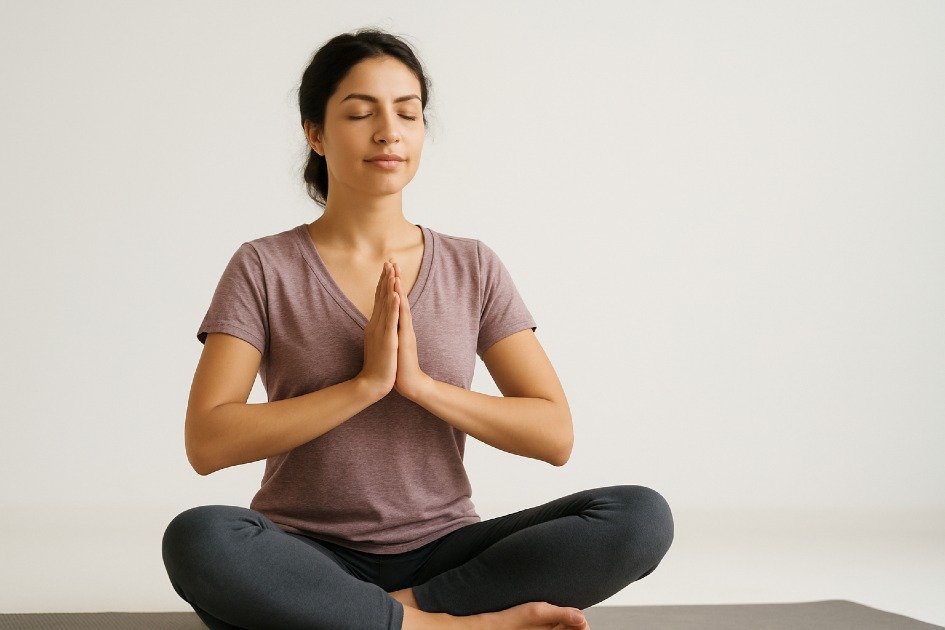
Mindful Movement: Connecting Body and Mind
Movement enhances awareness and mindfulness practices, connecting body and mind. It makes actions intentional, breath synchronized, and sensations a gateway to present-moment awareness, promoting clarity, calmness, and vitality.
Gentle Yoga Sequences for Focus and Relaxation
Why it matters:
Yoga connects body and consciousness, promoting flexibility, tension reduction, and mental clarity through gentle sequences and awareness, allowing stress to dissolve with each pose.
How to do it:
- Start with slow stretches, noticing each muscle stretch and wake up.
- Pay attention to how your body moves. Each part in motion instead of rushing.
- Breathe with your moves: inhale while lifting, exhale while lowering.
- Finish each session with a quick body scan. Notice tense areas and relax them gently.
- Choose a high-quality yoga mat or accessory to stay comfortable and focused during practice.
After yoga, I turn to a simpler movement that still sharpens my focus and calms my mind.
Walking Meditation to Clear Your Head
Why it matters:
A mindful walk enhances mundane tasks, reduces anxiety, sharpens attention, and grounds us in the present moment, making it a natural yet often autopilot activity.
How to do it:
- Walk slowly and notice how each foot touches the ground.
- Press your feet to the ground. Feel its texture, temperature, and weight under you.
- Walk in rhythm with your breath: take four steps while inhaling, four steps while exhaling.
- Notice the world around you—trees, clouds, or people—without judging them.
- If your mind wanders, calmly focus back on each step.
Once I walk without thinking, I use mindfulness to move with more awareness and energy.
How Exercise Becomes More Enjoyable with Mindful Awareness
Why it matters:
Mindful awareness enhances workouts into meditative experiences, improving form, reducing injury risk, and increasing satisfaction, even in vigorous exercise that can be stressful unconsciously.
How to do it:
- Begin by taking deep breaths to center your mind and body.
- Pay attention to each rep, feeling your muscles tighten and release.
- Know your limits and celebrate every small step forward.
- Take short pauses between sets to notice how your body feels and calm your mind.
- Use apps or tools that guide you through mindful workouts.
Breath-Integrated Movement for Emotional Release
Why it matters:
Breathing is crucial for movement, as it improves oxygen flow, calms the nervous system, and releases tension, and combining it with movement enhances mindfulness practices.
How to do it:
- Start with easy stretches, inhaling and exhaling slowly and evenly.
- Breathe in as you stretch or lift; breathe out as you bend or relax.
- Pay attention to how each breath changes your energy, posture, and mood.
- Spend 10–15 minutes each day strengthening your mind-body connection.
Integrating Mindful Movement into Daily Life
Why it matters:
Mindfulness practices can be incorporated into everyday activities like cleaning, gardening, or walking to work, ensuring sustainability and impactful outcomes beyond gyms and yoga studios.
How to do it:
- Notice how your body moves during daily tasks.
- Check your posture, feel your muscles work, and breathe steadily.
- Take short breaks to reset and ease stress.
- Place sticky notes or alerts around your space to remind yourself to stay mindful all day.
- Value every session—small step builds lasting results.
When I move mindfully, I notice my body and thoughts more clearly. These moments help me feel calm, stay grounded, and handle stress better over time.
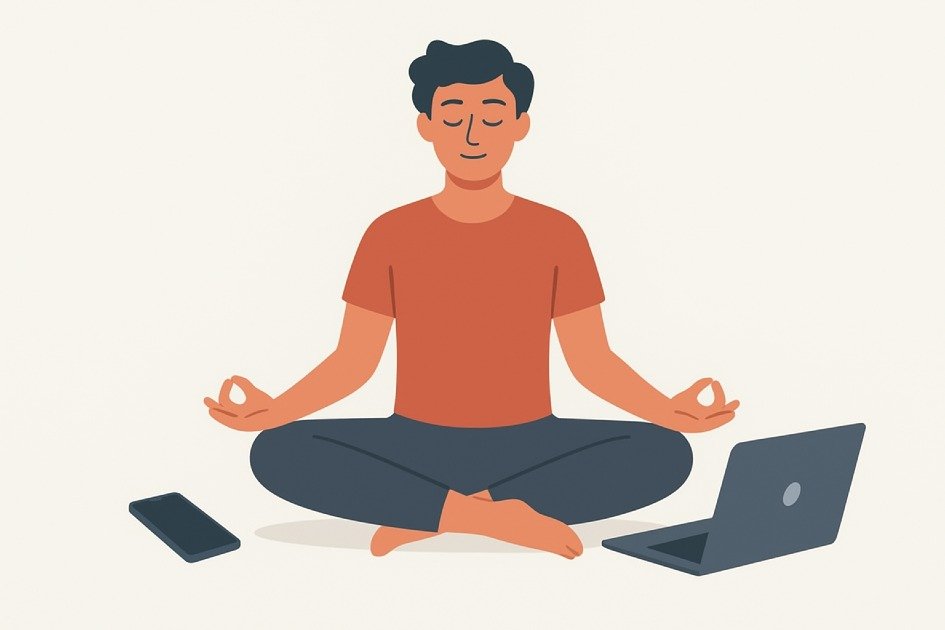
Technology and Mindfulness: Finding Balance in a Digital World
In today’s fast-paced world, screens hinder focus, rest, and social connections. Mindfulness practices are essential for mental clarity, emotional balance, and overall well-being.
Creating Tech-Free Zones
Why it matters:
Constant notifications and screen time can lead to increased stress, reduced focus, and disrupted sleep. Mindfulness encourages real presence in digital chaos.
How to do it:
- Keep rooms like your bedroom or dining area free of screens to boost focus, sleep, and family time.
- Put your phone away during meals and talks focus on people, not screens.
- Swap screen time for mindful activities like journaling or deep breathing.
- Feel calm and clarity when you step away from screens.
When I practice this, I focus fully on the moment, training my mind to stay present and calm.
Schedule Mindful Breaks from Screens
Why it matters:
Continuous scrolling can cause mental fatigue, hindering concentration and emotion processing. Intentional breaks can help reset the mind and reinforce presence.
How to do it:
- Set a timer to take a 5–10-minute break each hour. S
- Take breaks from screens and observe the world around you.
- Take three deep breaths, stretch, or walk for a few minutes to refresh your mind and body.
- Notice how your mood changes after each break.
I weave mindfulness into my day with a simple habit that takes no extra time but keeps me calm and focused.
Practice Digital Minimalism
Why it matters:
Minimizing digital noise can help reclaim mental space and focus by eliminating unnecessary apps, constant alerts, and notifications.
How to do it:
- Delete apps that waste your time and do not improve your life.
- Silence unneeded notifications.
- Use fewer apps and channels for messages.
- Take one tech-free hour each day to think, create, or reflect deeply.”
I use digital minimalism to keep my devices working for me, not the other way around. It helps me focus, stay calm, and get more done each day.
Using Mindful Technology Tools
Why it matters:
Technology can enhance mindfulness if used intentionally, with guided apps and timers helping to stay present and less distracted.
How to do it:
- Use meditation or focus apps to guide your breathing and calm your mind.
- Set daily alerts to pause and breathe mindfully.
- Monitor your screen time to spot habits you can improve.
- Use digital tools alongside offline habits like journaling to keep your mind balanced.
I use technology mindfully to balance my screen time with real life, turning digital tools into helpers for calm, focus, and healthy habits.
Set Boundaries for Social Media
Why it matters:
Social media can cause comparison, anxiety, and overstimulation, but mindful engagement can prevent it from consuming excessive mental energy.
How to do it:
- Use it only at set times—like 20 minutes in the morning or evening.
- Fill your feeds with uplifting and useful content that teaches or inspires.
- Pause before you like or comment—check if it helps your focus or peace.
- Notice how you feel after using it to understand yourself better.
I set clear boundaries to protect my focus and use my devices in ways that support mindfulness.
Embrace Offline Activities
Why it matters:
Offline experiences promote creativity, presence, and genuine human connection, ensuring the mind remains in the present moment.
How to do it:
- Take a daily walk outside or spend a few minutes on mindful breathing to refresh your body and calm your mind.
- Do screen-free hobbies like painting, reading, or crafting to relax your mind and boost creativity.
- Spend time face-to-face with friends or family whenever you can.
- Notice your stress drops when you disconnect from screens and slow down.
I practice offline mindfulness to stay focused, lower stress, and manage my emotions better. By using technology on purpose, I stay fully present in each moment of my life
Recap: Embracing Mindfulness as a Way of Living
Mindfulness Practices can transform your inner world and the world around you. By committing to these practices, you can become more present, grounded, and at peace, navigating life’s chaos with clarity.
Consistent mindfulness helps cultivate resilience, joy, and appreciation for everyday life. These practices can also impact relationships, productivity, and health, enhancing focus, enriching connections, and nurturing emotional balance.
Harvard Health suggests that mindfulness practices, such as focused breathing or guided meditation, can significantly improve mental well-being, reduce anxiety and depression symptoms, and promote healthier lifestyle choices.
The journey of integrating mindfulness is deeply personal, and it is a lifelong invitation to transform mundane routines into meaningful rituals. Remember, every mindful choice contributes to a richer, more intentional life.
Frequently Asked Questions
How much time should I spend on mindfulness practices each day?
Mindfulness practices, even 5-10 minutes daily, can significantly improve focus, reduce stress, and calm responses. Consistency is key, and experts recommend integrating small mindful pauses into routines for busy schedules.
Can mindfulness practices help with anxiety and stress?
Mindfulness practices, including breath awareness, walking, and body scans, reduce stress hormones, lower cortisol levels, and improve emotional resilience, making everyday challenges more manageable.
Do I need to meditate to be mindful?
Mindfulness practices, including daily activities like eating, washing dishes, and walking, promote conscious awareness and can be achieved through brief, consistent moments of focus.
How quickly will I see results from practicing mindfulness practices?
Mindfulness practices lead to subtle changes like increased awareness, improved emotional regulation, and reduced reactivity, with tangible benefits like improved sleep and concentration after consistent practice.
What are simple ways to stay consistent with mindfulness practices?
Integrating mindfulness into daily routines, linking practice to existing habits, using guided tools, setting realistic goals, and celebrating small wins promotes consistency and sustainability.
Can mindfulness practices improve my relationships?
Mindfulness practices improve empathy, listening skills, emotional attune, patience, and emotional responses, fostering deeper connections in personal and professional life over time.
Are mindfulness practices suitable for children and teens?
Mindfulness practices, such as mindful breathing, guided meditation, and sensory awareness, are beneficial for children and teens, promoting focus, emotional regulation, and stress management from an early age.
Can I combine mindfulness practices with other wellness routines?
Mindfulness practices enhance fitness, nutrition, sleep, and overall wellness by promoting movement, digestion, and enjoyment of food, ensuring a holistic approach to wellness.
Do I need a quiet space to practice mindfulness?
Mindfulness practices cultivate awareness in any situation, allowing for inner calm and turning everyday moments into mindfulness opportunities, even in noisy or crowded settings.
Where can I find reliable resources to enhance my mindfulness practices?
Various tools, including apps, books, online courses, and wellness platforms, offer guided sessions for mindfulness, ensuring safe, effective, and transformative practices when chosen from credible sources.

